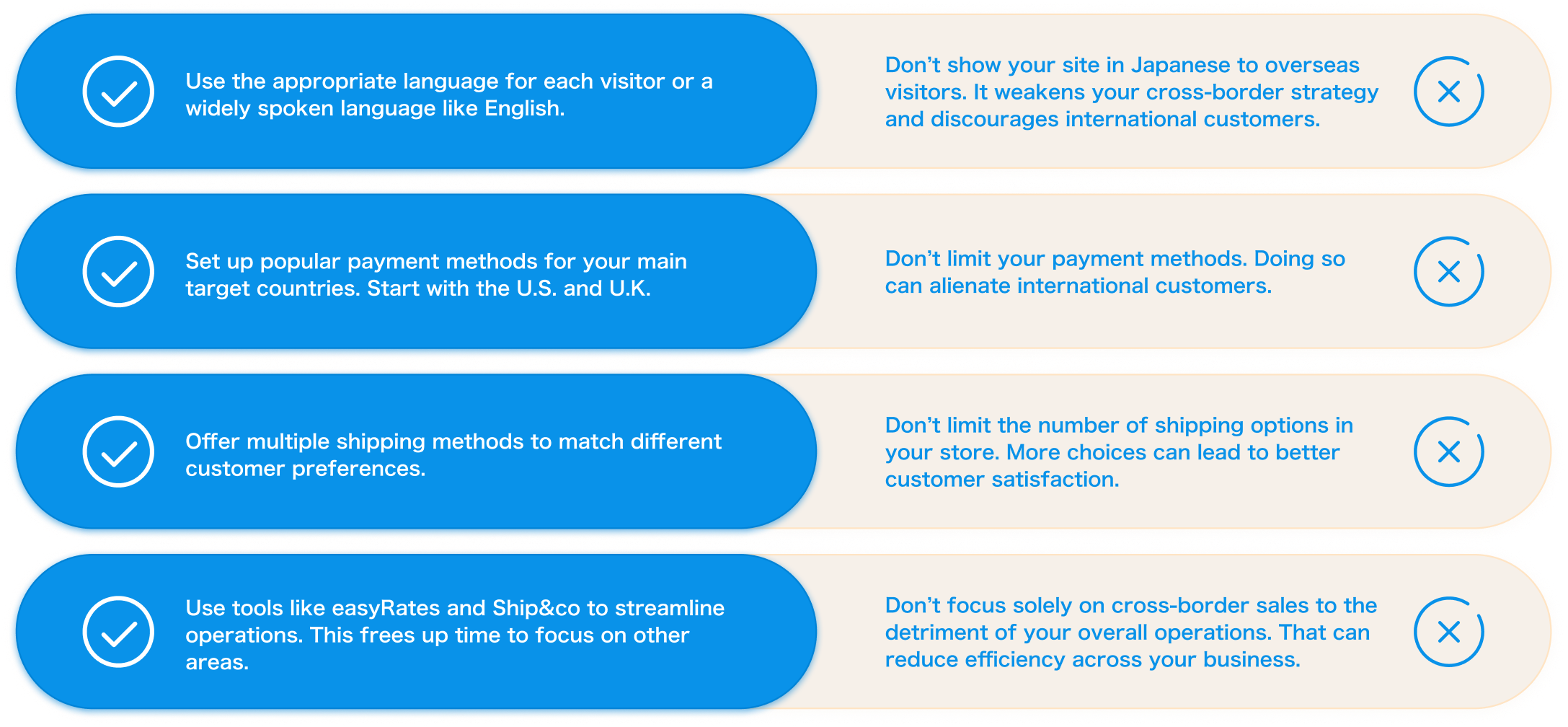
The start guide to cross border E-commerce Volume-1 :
Language and Regional Differences
2025/06/10
One of the biggest advantages of having an online store is that customers can shop without geographical or time constraints. But are you really making the most of this strength?
Of course, being able to deliver products across Japan already gives you a wide reach—but what if you extended that reach to the entire world? Don’t you think it could significantly boost your sales?
Many merchants hesitate to take the first step into cross-border e-commerce, or even if they’ve started, they’re unsure about what to watch out for. In this article, we’ll introduce key points to consider when launching or optimizing your cross-border store, based on success stories from other businesses.
01
The Right Mindset for Cross-Border E-Commerce
What You Do for Customers Will Lead to Results
Put Yourself in the Customer’s Shoes
02
Language and Regional Differences
Store Language
Currency
Payment Methods
Shipping Options
The Right Mindset for Cross-Border E-Commerce
What You Do for Customers Will Lead to Results
Just like domestic e-commerce, cross-border sales won’t suddenly explode overnight. Often times, trying out small actions and improving day by day leads to long term success.
Even large stores today started small. Many spent time personally assisting customers via live chat or carefully calculating costs to maximize profits. Those early efforts built the foundation for later growth.
By consistently providing small touches of support, thoughtful design, and low-cost strategies, you can earn the trust of your customers.
Put Yourself in the Customer’s Shoes
One successful cross-border store was inspired by the founder’s own unpleasant online shopping experiences. They reversed those negative points and structured their operations to be more customer-friendly, ultimately gaining trust and loyalty.
Other stores have improved their responsiveness in support and made shipping status updates clearer, so customers feel reassured throughout the buying process.
Avoid doing anything that might create discomfort for your customers. Even small gestures of care can build strong relationships over time.
Key Points to Remember for Cross-Border E-Commerce ①
Language and Regional Differences
Language is one of the biggest barriers when selling across borders.
- Store Language
Have you made your store accessible to international customers—but the site still defaults to Japanese? Shopify offers both built-in translation functions and third-party apps to support multiple languages.
Be sure that visitors see your store in English or other familiar languages, depending on the market. Review your default language settings and translation apps to ensure users are greeted in their native language whenever possible.
- Currency
Even if your site is in English or Chinese, many stores still show prices only in Japanese yen. Just as you’d convert currencies when shopping abroad, your customers must do the same.
Make shopping easier by offering multiple currencies. Shopify Markets lets you set up local currency payments, and other Shopify apps can help display them.
商品価格: ¥2,000
20pt 獲得
2点以上購入で10%off!
Price: $14.00
20 points
10%off by purchasing more than 2!
商品价格: 100元
可获得 20 积分
购买两件及以上可享受九折优惠
Prix du produit: €13
20 points
10 % de réduction à partir de 2 articles achetés
- Payment Methods
Know your target markets and identify where most of your international customers come from. Familiarize yourself with the preferred payment methods in key countries:
China: Alipay
U.S. & U.K.: PayPal
Global: Visa, Mastercard
Also consider region-specific options like Giropay (Germany), Klarna (Sweden), and Sofort (EU countries). Just as Japanese stores offer PayPay or convenience store payments, each country has its own preferences. Offering installment payments can also help boost conversions.
You can add most payment methods via Shopify's "Payments" settings. If certain methods aren't available, search the Shopify App Store—these days, it's rare not to find a compatible solution.
While third-party tools like withreach or Komoju can assist with cross-border transactions, they may come with additional costs, so have a think about it before usage.
- Shipping Options
Customers have different preferences: some want fast delivery at a higher price, while others prefer lower-cost options with slower delivery. To meet diverse needs, offer a variety of shipping methods.
Also provide detailed explanations of each shipping option in a widely used language like English. Include estimated delivery times and any relevant notes.
Apps like easyRates allow you to add various Japan Post shipping options, calculate fees automatically, and include clear explanations.

Summary
This article introduced the first key point for succeeding in cross-border e-commerce: understanding language and regional differences. When entering global markets, it’s crucial to recognize that your customers are not Japanese—and you must create an experience that feels just as seamless as shopping on their local sites.
By removing common friction points related to language, currency, payment, and shipping, you’ll not only increase your chances of converting visitors but also encourage repeat purchases. These are the foundational elements of cross-border e-commerce, and without them, your store hasn’t even reached the starting line.
Take these lessons to heart and build your store with the customer’s experience in mind.
In the next article, we’ll explore communication and marketing strategies for cross-border e-commerce.
Please contact support@lunaris.jp for additional support
Access This link to start a Chat conversation with our team.




